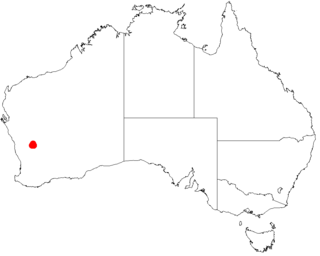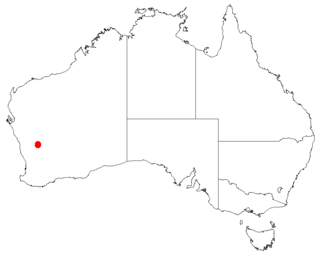
Acacia cyclops, commonly known as coastal wattle, cyclops wattle, one-eyed wattle, red-eyed wattle, redwreath acacia, western coastal wattle, rooikrans, rooikrans acacia, is a coastal shrub or small tree in the family Fabaceae. Native to Australia, it is distributed along the west coast of Western Australia as far north as Leeman, and along the south coast into South Australia. The Noongar peoples of Western Australia know the plant as wilyawa or woolya wah.

Acacia enterocarpa, commonly known as jumping jack wattle, is a shrub species that is endemic to eastern Australia.

Acacia ramulosa, commonly known as horse mulga or bowgada wattle, is a shrub belonging to the genus Acacia and the subgenus Juliflorae endemic to arid areas of Australia.

Acacia dermatophylla is a shrub belonging to the genus Acacia and the subgenus Phyllodineae that is endemic to southern parts of Western Australia.

Acacia glaucocaesia is a shrub or tree belonging to the genus Acacia and the subgenus Phyllodineae that is endemic to north western parts of Australia.

Acacia imitans, also commonly known as Gibson wattle, is a shrub belonging to the genus Acacia and the subgenus Phyllodineae that is endemic to south western Australia. It is a declared endangered species under the West Australian and Australian Acts, and is on the IUCN Redlist.

Acacia maxwellii is a shrub belonging to the genus Acacia and the subgenus Phyllodineae that is endemic to south western Australia.

Acacia merrallii, commonly known as Merrall's wattle, is a shrub belonging to the genus Acacia and the subgenus Phyllodineae that is endemic to south western and southern Australia.

Acacia strongylophylla, commonly known as round-leaf wattle, is a shrub of the genus Acacia and the subgenus Phyllodineae endemic to central Australia.

Acacia vassalii, commonly known as Vassal's wattle, is a shrub of the genus Acacia and the subgenus Phyllodineae that is endemic to a small area of south western Australia. It is listed as critically endangered with the World Conservation Union, as endangered according to the Environment Protection and Biodiversity Conservation Act 1999 and as rare flora with the Wildlife Conservation Act 1950 in Western Australia.

Acacia ancistrophylla is a shrub of the genus Acacia and the subgenus Plurinerves that is native to several areas on southern Australia.

Acacia assimilis, also known as fine-leaf wodjil, is a shrub or tree of the genus Acacia and the subgenus Plurinerves that is endemic to an area in the south-west of Australia.

Acacia awestoniana, commonly known as the Stirling Range wattle, is a shrub of the genus Acacia and the subgenus Plurinerves.

Acacia octonervia is a shrub of the genus Acacia and the subgenus Plurinerves that is endemic to a small area along the south western coast of Australia.

Acacia oswaldii, commonly known as boree, umbrella wattle, umbrella bush, whyacka, middia, miljee, nella and curly yarran, is a shrub or tree of the genus Acacia and the subgenus Plurinerves.

Acacia unguicula is a shrub of the genus Acacia and the subgenus Plurinerves. It is native to a small area in the Mid West region of Western Australia.

Acacia viscifolia is a shrub of the genus Acacia and the subgenus Plurinerves that is endemic to an area of south western Australia.

Acacia grisea is a shrub of the genus Acacia and the subgenus Pulchellae that is endemic to an area of south western Australia.

Acacia pentadenia, commonly known as karri wattle, is a shrub or tree of the genus Acacia and the subgenus Pulchellae.

Acacia varia is a shrub of the genus Acacia and the subgenus Pulchellae that is endemism to an area of south western Australia.






















